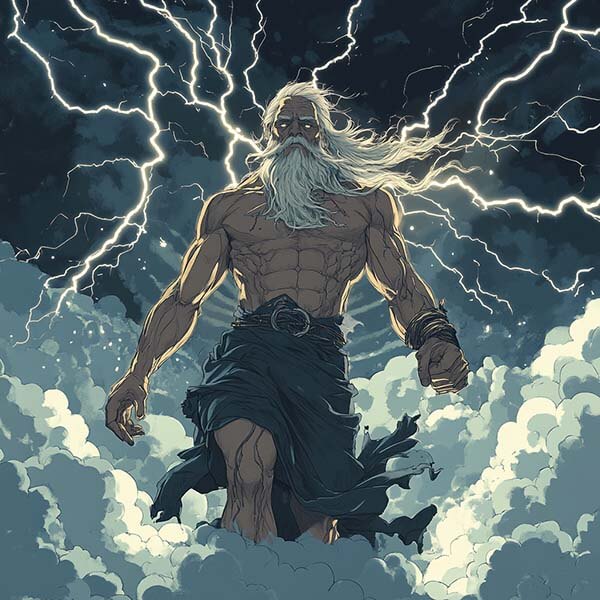
Ukko
God of the Sky
Karelian / Finnish Mythology
Ukko’s name translates to “old man;” however, “Ukkonen” is also the Finnish word for thunder. He is the god of the sky, thunder, and weather and the principal god in Kalevala. His control of the weather affects the crops and, therefore, the lifestyle of the people on Earth. Portrayed as an old man, Ukko symbolizes divine authority, knowledge, and experience.
Ukko resides in Taivas, although his wife Akka, or “older lady,” resides on Earth and is the goddess of fertility, Earth, and nature. Their duality symbolizes the bond between masculine and feminine energy in the universe.
Sitting on a cloud in the Vault of the Sky, Ukko is a mighty warrior, using a rainbow as his bow with copper arrows. He also wields lightning in the form of his sword or hammer. While Ukko never reveals himself in form during the Kalevala, he grants favors in the form of natural phenomena.
- Domain: The sky, thunder, and weather
- Realm: Taivas
- Symbol: Rowan Tree
- Weapon/Relic: Ukonvasara, “Ukko’s Hammer”
- Spouse: Akka
- Worship: Bonfire burning, feasts
- Offerings: Beer, bread, and honey
- Holidays: Juhannus (Midsummer Festival) and Vakkajuhlat or Vakkas
Ukko’s Role in The Kalevala
While the heroes play the central roles in The Kalevala, they ask Ukko for favors to overcome their trials. Throughout their adventures, the heroes call upon him several times in times of need.
Forging of the Sampo
The Sampo is the most important relic in the Kalevala. It has the power to create unlimited grain, salt, and gold, meaning it is a source of wealth for whoever possesses it. Väinämöinen initially agrees to create this relic for Louhi in exchange for one of her daughters’ hands in marriage.
When Väinämöinen must create the sacred Sampo for Louhi, he enlists the help of Ilmarinen, The Eternal Blacksmith. Despite his skill, they must call upon Ukko, who sends a divine fire to power the forge to complete the sacred artifact.
Lemminkäinen’s Favors
The first and perhaps most significant favor Ukko grants Lemminkäinen is providing his mother with the sacred honey to bring him back to life. After his death and dismemberment, Lemminkäinen’s mother sews his body back together but requires the sacred honey to restore his life. She sends a bee to collect a thimble of sacred honey to complete this task.
Lemminkäinen also calls upon Ukko in his travels throughout Pohjola. Lemminkäinen must overcome a valley fiery chasm when traveling to attend the feast. He prays to the old man to quench the fire, who sends a storm to answer the prayer.
Väinämöinen’s Favors
While Väinämöinen is to Pohjola, he gets lost at sea. Unable to navigate back to the shore, the hero prays to the old man to aid his travels. Ukko provides a strong gale to guide Väinämöinen back to safety.
After Louhi steals the Sun and the Moon, Väinämöinen must restore order to the world. During this quest, Väinämöinen receives an axe wound on his knee from Hiisi, the devil. While Väinämöinen prays to Ukko to heal this ailment, ultimately, the God of Thunder is unable to heal his wounds.
Ukonvasara
The symbol of Ukko is very similar to Thor’s hammer. However, the Ukonvasara is a boat-shaped hammer. Striking Ukonvasara creates lightning bolts. Although the Ukonvasara is significant, riding his chariot across the heavens and copulating with his wife, Akka, were other ways followers perceived lightning.
Celebrating Ukko
Ukko’s celebrations correspond to significant times of the harvest season. Although livestock offerings might’ve been an earlier traditional offering, most honored Ukko with honey, bread, and beer; honey was particularly favored as it symbolized the sweetness of life.
Burning bonfires during the Midsummer Festival was also a popular way to honor Ukko. Followers believed that the smoke of the bonfires carried prayers up to the heavens.
Juhannus (Midsummer Festival)
The Midsummer Festival celebrates the turn of the seasons and marks the start of summer. It is also the longest day of the year. Prior to Christianity arriving in Finland, Juhannus was called Ukon Juhla.
Juhannus is an important celebration for the Finns, although this tradition initially started as a celebration of Ukko specifically. Bonfires are lit as a ritual to bring good harvest and weather for the summer.
Modern Finns also take time to enjoy saunas during Juhannus, which symbolizes renewal and purity for the summertime. Sauna goers use vihta, a bundle of birch branches, to flog their skin, enhancing exfoliation.
Vakkajuhlat or Vakkas
Vakkajuhlat is celebrated in May, during spring sowing. Its celebrations honor Ukko, who controls the weather and yields good crops. To celebrate Vakkajuhlat, one often consumes or offers a vessel of alcoholic beverages or food. Held near holy springs, revelers dance, and consumer libations to ensure a good harvest and weather for the year.
With the adoption of Christianity, the festival eventually lost prominence in modern Finland, although it was reportedly celebrated until 1910.
